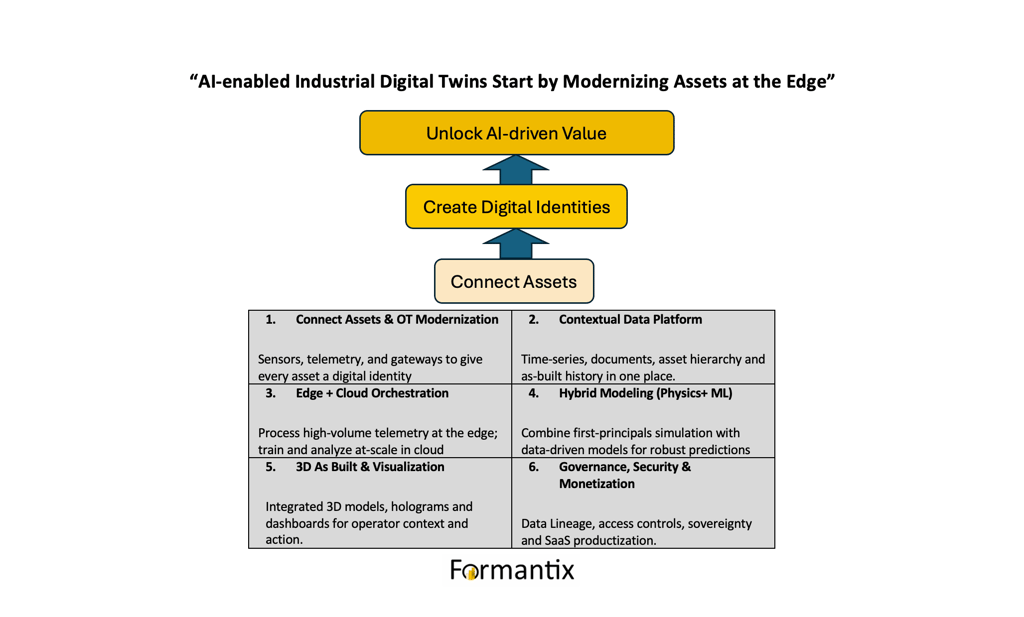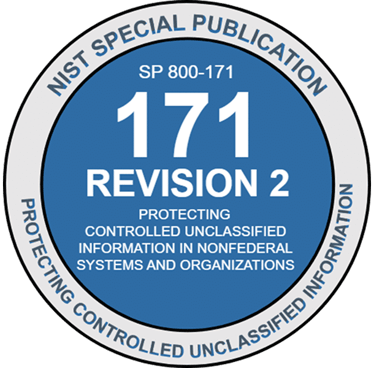The future of Industrial Digital Twins — why the AI race begins at the edge.
AI doesn’t beat humans at operations — it augments decisions where data is clean, contextual and timely. At Formantix we believe the AI race begins at the edge: connect your assets, create a digital twin and then let AI multiply operational value. Read our briefing on how to modernize safely and start generating ROI here.
8/13/20254 min read


By Formantix Consulting — bridging engineering excellence with ROI-driven AI & digital platforms.
AI will transform industrial operations — but only for organizations that first modernize their assets. The digital twin is the necessary foundation that turns raw telemetry into trusted, contextualized knowledge. At Formantix we believe the AI race “begins at the edge” because connecting each asset, giving it a digital identity and capturing clean, contextual data are prerequisites to safe, timely and cost-effective AI. Without that foundation, AI becomes noise; with it, AI becomes an economic multiplier.
Why modernize assets first (practical reality, not slogan)
AI needs trustworthy data. Models trained on incomplete, siloed or low-quality records will produce low-confidence outputs. Connecting assets and building a digital twin ensures the telemetry, maintenance logs and as-built history required for robust ML.
Digital identity enables lifecycle value. In an industrial facility when every pump, heat exchanger or transformer has a persistent, versioned digital record, you can trace failures, simulate retrofits and monetize insights across assets and sites.
You cannot “bolt on” AI to an uninstrumented plant. Many early AI pilots fail because the ground truth and operational context aren’t available. Modernization — sensors, gateways, standardized tagging and a consistent asset model — is the first engineering step.
Edge-first deployment protects operational continuity. Some decisions must be made with millisecond latency, independent of cloud availability. Modernized assets with local processing capabilities keep systems safe and responsive.
Why the AI race begins at the edge — a deeper view
Saying “AI begins at the edge” isn’t a marketing line — it’s an operational thesis grounded in several realities:
Latency & safety: Critical control and protective actions often require sub-second responses. Edge inference makes control loops safe, predictable and independent of network variability.
Data volume & cost: Industrial systems generate massive time-series telemetry. Sending every bit to the cloud increases bandwidth costs and raises noise-to-signal ratios. Pre-processing at the edge filters, aggregates and enriches data so only valuable information moves up the stack.
Privacy, sovereignty & control: Industrial data is strategic. Edge architectures let organizations keep sensitive raw data on-prem for governance, legal compliance or competitive advantage while sharing derived insights selectively.
Resilience & availability: Edge systems continue to operate during network outages. This is non-negotiable for critical infrastructure where cloud access cannot be assumed.
Faster feedback loops: Localized models enable immediate operator assistance, faster root-cause identification and iterative model retraining patterns that reflect real-world dynamics sooner.
Domain adaptation: Industrial environments vary widely. Edge-deployed models can be customized and fine-tuned on-site (few-shot or continual learning) so they align with local physics, equipment models and operating practices.
In short: the edge is where data is produced, where critical decisions are made and where control must remain. Winning the AI race means controlling and curating that first mile of data.
What AI enables once assets are modernized
With connected assets and a well-constructed digital twin, AI shifts from curious pilot to mission-critical capability:
Predictive maintenance that prevents failures and optimizes spare-parts inventory.
Prescriptive operations that simulate “what-if” scenarios in the twin before real-world execution.
Automated compliance & reporting by stitching documents, inspection logs and sensor traces to an authoritative asset record.
Operator augmentation via contextualized, explainable recommendations delivered on 2D dashboards or 3D visualizations.
Six building blocks for practical, AI-enabled digital twins
Connected assets & OT modernization — sensors, gateways and consistent tagging to create asset digital identities.
Contextual data platform — time-series storage, documents, work orders and as-built histories linked to each asset.
Edge + cloud orchestration — inference & pre-processing at the edge; large-scale training and analytics in the cloud.
Hybrid modeling (physics + ML) — combine first-principles simulations with machine learning to increase model robustness and explainability.
3D as-built & visualization — integrated geometry, spatial context and operator-facing visual interfaces for faster decisions.
Governance, cybersecurity & monetization — data lineage, access controls, sovereignty and pathways to productize operational insights as SaaS offerings.
We envision a future where the AI race begins at the edge—with every physical asset connected, every process optimized, and every organization empowered by data. Digitalizing infrastructure isn’t just modernization—it’s the foundation for the next era of innovation. At Formantix, our mission is to bridge engineering excellence with ROI-driven technologies that work—turning industrial operations into intelligent systems that unlock efficiency, resilience and growth. We help clients turn internal capabilities into customer-facing SaaS platforms—creating new, recurring revenue streams to support their transformation journey.
Practical steps to start — a suggested roadmap
Inventory & asset digital identity: map high-value assets and create consistent IDs and metadata.
Pilot an edge-enabled twin on a single high-impact system (e.g., a critical pump train).
Build the data platform to ingest both streaming telemetry and historical records.
Deploy hybrid models and integrate results into operator workflows.
Formalize governance so data can be trusted, used and monetized safely.
Where Formantix helps
We combine domain engineering, OT modernization experience and pragmatic platform delivery to help industrial leaders:
prioritize asset modernization with ROI-driven roadmaps;
design edge-first architectures that respect latency and sovereignty constraints;
build robust digital twins combining physics and ML;
productize operational capabilities into SaaS revenue while keeping the client’s data and IP secure.
If you manage industrial infrastructure, start by digitizing your assets. The AI gains follow reliably from a foundation of connected, well-governed data. Formantix can guide your roadmap, deliver the pilot and turn engineering know-how into ongoing SaaS value.
References & further reading
Origins and definitions of the digital twin concept: Michael Grieves / Digital Twin origins. ResearchGate
Digital twin + generative AI pairing and business impact: McKinsey — “Digital twins and generative AI: A powerful pairing.” McKinsey & Company
Market & growth signals: Grand View Research — Digital Twin market and Edge AI market overviews. Grand View Research+1
Industrial case studies (Shell Pulau Bukom, BP digital twin efforts) and value examples: Shell & BP materials and reporting. RCR Wireless NewsMicrosoft
Security & governance: NIST IR on “Security and Trust Considerations for Digital Twin Technology” and NIST work on interoperability & cybersecurity. NIST Computer Security Resource CenterNIST



info@formantix.co
+1 (512) 730-0211
Copyright @ 2025 Formantix LLC. All Rights Reserved.












